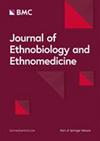Can family structure and contact with natural resources influence young people’s knowledge about medicinal plants? An approach in the Northeast of Brazil
IF 3.7
2区 医学
Q1 BIODIVERSITY CONSERVATION
引用次数: 0
Abstract
Individuals develop crucial survival knowledge in the juvenile phase, including understanding medicinal plants. The family context or contact with resources can influence this dynamic knowledge. By investigating the influence of these factors on young people's understanding of medicinal plants, we aimed to enhance our understanding of the knowledge-building process. The study was conducted in three communities in the State of Alagoas, Brazil: Lagoa do Junco, Serrote do Amparo, and Brivaldo de Medeiros. Semi-structured interviews were conducted with young people aged between 11 and 19 to assess their knowledge of medicinal plants. We used a generalized linear mixed model (GLMM) with the number of therapeutic targets and known medicinal species (knowledge proxy) as response variables. As predictors, we included the number of individuals per family unit and the gender distribution within the famimunícpily (family context proxy), as well as dependence on the use (contact proxy). Location (city) was added as a fixed effect to the model. We investigated how knowledge of medicinal plants correlates with the practice of collecting these species. We did not identify a relationship between the number of individuals per household, gender distribution within the family, and the frequency of medicinal plant use with knowledge about these species. However, we observed a positive, albeit weak, correlation between knowledge of medicinal species and the number of species collected. These results highlight the importance of investigating how young people acquire knowledge about medicinal plants, emphasizing the complex interactions between humans and nature, and providing a basis for future research.家庭结构和与自然资源的接触能否影响年轻人对药用植物的了解?巴西东北部的一种方法
个体在幼年时期积累了重要的生存知识,包括了解药用植物。家庭环境或与资源的接触会影响这种动态知识。通过调查这些因素对年轻人了解药用植物的影响,我们希望加深对知识积累过程的了解。这项研究在巴西阿拉戈斯州的三个社区进行:这三个社区是:Lagoa do Junco、Serrote do Amparo 和 Brivaldo de Medeiros。我们对 11 至 19 岁的青少年进行了半结构化访谈,以评估他们对药用植物的了解程度。我们采用广义线性混合模型(GLMM),将治疗目标和已知药用植物种类的数量(知识替代变量)作为响应变量。作为预测变量,我们纳入了每个家庭单位的人数和家庭内部的性别分布(家庭背景替代变量),以及对使用的依赖性(接触替代变量)。地点(城市)作为固定效应被添加到模型中。我们研究了药用植物知识与采集这些物种的实践之间的关系。我们没有发现每个家庭的人数、家庭中的性别分布以及使用药用植物的频率与这些物种的知识之间存在关系。不过,我们观察到药用植物知识与采集物种数量之间存在正相关,尽管这种相关性很弱。这些结果突出了调查年轻人如何获得药用植物知识的重要性,强调了人与自然之间复杂的相互作用,并为未来的研究提供了基础。
本文章由计算机程序翻译,如有差异,请以英文原文为准。
求助全文
约1分钟内获得全文
求助全文
来源期刊

Journal of Ethnobiology and Ethnomedicine
PHARMACOLOGY & PHARMACY-
CiteScore
7.30
自引率
16.70%
发文量
66
审稿时长
>12 weeks
期刊介绍:
Journal of Ethnobiology and Ethnomedicine publishes original research focusing on cultural perceptions of nature and of human and animal health. Journal of Ethnobiology and Ethnomedicine invites research articles, reviews and commentaries concerning the investigations of the inextricable links between human societies and nature, food, and health. Specifically, the journal covers the following topics: ethnobotany, ethnomycology, ethnozoology, ethnoecology (including ethnopedology), ethnogastronomy, ethnomedicine, ethnoveterinary, as well as all related areas in environmental, nutritional, and medical anthropology.
Research focusing on the implications that the inclusion of humanistic, cultural, and social dimensions have in understanding the biological word is also welcome, as well as its potential projections in public health-centred, nutritional, and environmental policies.
 求助内容:
求助内容: 应助结果提醒方式:
应助结果提醒方式:


